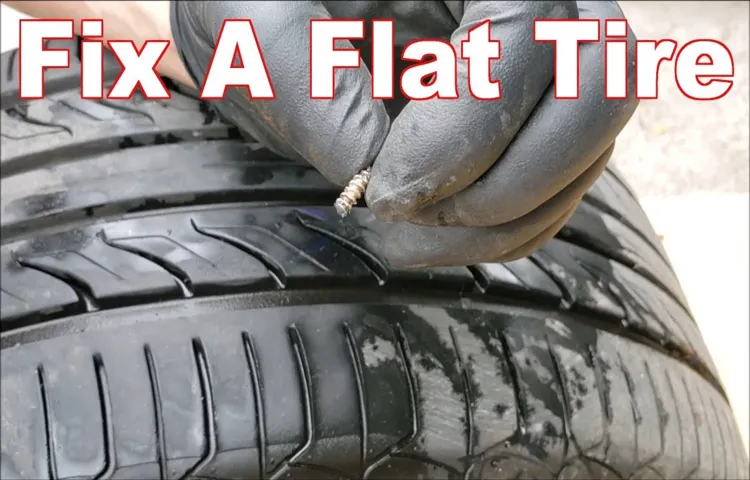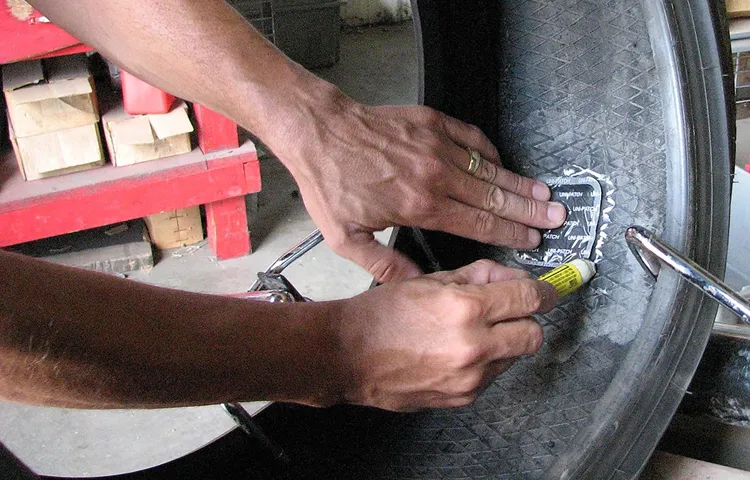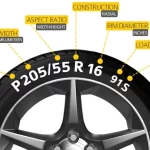Have you ever been stuck on the side of the road with a flat tire, wondering how much it’s going to cost you to get back on the road? Flat tire repair cost can vary depending on many factors, such as the type of tire, the severity of the damage, and your location. However, it’s important to know what to expect to avoid being overcharged. Repairing a flat tire can range from a simple patch job to a complete tire replacement, and the cost can vary from as low as $20 to as much as $200.
The cost of repair or replacement also depends on the type of tire, whether it’s a standard or premium tire. Location also plays a factor in the cost of flat tire repair. If you’re in the middle of nowhere, you might end up paying more for a tow truck to take you to the nearest repair shop.
In this blog post, we’ll give you a breakdown of what to expect when dealing with flat tire repair cost, discuss the different factors that can affect the price, and provide tips on how to save money on flat tire repair. So buckle up and let’s dive in!
Table of Contents
Factors Affecting Flat Tire Repair Cost
If you’re wondering how much it’ll cost to repair a flat tire, there are a few factors that can affect the price. The first thing you should consider is the type of tire you have – different vehicles require different types of tires, and some can be more expensive to fix than others. Additionally, the severity of the damage to the tire can play a role in the repair cost.
If you catch the problem early and the tire only needs a patch, the cost will likely be less than if you wait and need to replace the entire tire. Another factor to consider is where you go to have the repair done. Chain repair shops and dealerships may charge more than a local mechanic, so it’s important to shop around and compare prices.
Finally, it’s worth noting that in some cases, a flat tire may not be repairable and will need to be replaced entirely – which will obviously be more expensive. Ultimately, the best thing you can do is keep up with regular tire maintenance to catch any issues early and avoid unexpected costs.
Cause of Tire Damage
Flat tire repair cost may vary depending on several factors affecting the tire damage. The leading cause of tire damage is punctures, caused by sharp objects such as nails and screws, which can make a hole in the tire’s tread. Road hazards, such as potholes or debris, can also cause damage to the tire, leading to either a flat or an unavoidable puncture.
Tire age and usage are also factors that contribute to tire damage. The older the tire, the more susceptible it is to damage, which can cause it to fail during use. Another factor that affects a tire’s lifespan is driving habits, such as overloading or under-inflating the tire, which can cause excessive wear and tear.
Finally, weather conditions can affect tire damage and repair costs. High temperatures and excessive exposure to ultraviolet rays may cause tires to dry out and crack, leading to possible punctures or flattening. These factors all contribute to the flat tire repair cost, making it necessary for drivers to take care of their tires, maintain proper inflation levels, and avoid hazardous road conditions.

Type of Tire
When it comes to flat tires, the type of tire you have can have a significant impact on the repair cost. Factors such as the size, brand, and tread design may all affect the price of repairing a flat tire. For instance, if you have luxury or high-performance tires, it can cost more to repair them due to their specialized design and need for specific tools.
Additionally, the type of tire may affect the ease of repair, with some requiring more labor and time to fix than others. It’s essential to consider these factors when choosing new tires or when repairing a flat tire to avoid any surprise costs. Apart from the type of tire, factors like the location of the flat, the extent of the damage, and the level of experience of the mechanic may all impact the repair cost.
Therefore, you should always consult a professional to advise on the best course of action when repairing a flat tire to minimize the cost.
Location
Location Flat tires can be a real headache, and the cost of repairing them can vary depending on several factors. One of these is the location where the tire repair is performed. If you’re on the side of the road in the middle of nowhere, you can expect the repair cost to be higher than if you’re in a well-equipped tire repair shop in the city.
The reason for this is because the cost of traveling to a remote location can be significant, and the repair technician may not have all the necessary tools and equipment with them. On the other hand, if you’re in a tire repair shop located in a busy city, you’re likely to pay less because the repair technician would have all the tools and equipment needed to perform the repair quickly and efficiently. In addition, the repair shop may have a larger inventory of tires, which means they can offer a wider range of options and prices for replacement tires.
Therefore, when it comes to the cost of repairing a flat tire, location matters a great deal.
Average Cost of Flat Tire Repair
Are you wondering how much flat tire repair will cost you? The average cost of a flat tire repair can range from $20 to $40 depending on where you go and what type of tire you have. If you have a high-performance tire or a run-flat tire, the cost may be higher. Additionally, if you need to have your tire replaced, the cost will be higher than if you just need a patch for a small hole.
It is important to remember that driving on a flat tire can cause damage to your rim, so it is best to get it fixed as soon as possible. Overall, the cost of a flat tire repair is relatively affordable and well worth the peace of mind it provides while out on the road.
National Average Cost
The average cost of flat tire repair across the United States varies depending on a few factors. According to recent data, the national average cost of repairing a flat tire is about $50 to $7 However, this cost can be higher or lower depending on where you live and the type of tire that needs to be repaired.
For example, if you live in a big city like New York or Los Angeles, the cost of repairing a flat tire can be more expensive due to higher labor costs. On the other hand, if you’re in a rural area, the cost can be lower because of lower overhead costs. It’s always a good idea to shop around and compare prices before deciding on a repair shop.
Additionally, the cost of a new tire may be more cost-effective compared to a flat tire repair, so it’s important to weigh your options carefully. Overall, while the national average cost of flat tire repair may give you an idea of what to expect, it’s important to remember that prices may vary depending on your location and the specifics of your tire issue.
Range of Price
When it comes to fixing a flat tire, the cost can vary depending on a variety of factors. On average, the cost of repairing a flat tire ranges from $20 to $40. However, this price can increase if other parts of the tire need to be replaced, such as the valve stem or tire pressure monitoring system.
Additionally, the cost can vary depending on where you live and the type of vehicle you have. For example, if you have a luxury car, the cost of repairing a flat tire may be higher due to the cost of the specialized tires. On the other hand, if you have a compact car, the cost may be lower since the tires are less expensive.
It’s essential to shop around and compare prices at different shops to get the best deal possible. Ultimately, it’s important to address a flat tire as soon as possible to avoid causing further damage to your vehicle and ensure your safety on the road.
DIY Flat Tire Repair
If you’ve ever found yourself with a flat tire, you know how frustrating it can be. The good news is that you don’t always have to rely on a mechanic to fix the problem. With a few basic tools and some know-how, you can take care of the issue yourself and save some money in the process.
The cost of a flat tire repair can vary depending on where you go, but on average, you’re looking at around $20-$30 for a patch or plug. However, if you’re in a rush or need to get back on the road quickly, you could be looking at a higher price. That’s why learning how to repair a flat tire yourself can come in handy.
The process involves removing the tire from the wheel, locating the puncture, and using a patch or plug to seal it up. With proper placement and adherence to safety precautions, DIY flat tire repair can be a viable option that saves time and money.
Tools and Supplies Needed
DIY flat tire repair, tools and supplies Having a flat tire is not only frustrating, but it can also be dangerous if not handled correctly. Luckily, with the right tools and supplies, you can perform a DIY flat tire repair yourself, saving you time and money. The first tool you’ll need is a jack to lift your car.
Most cars come with a spare tire, which you’ll also need to have on hand. Additionally, a lug wrench or tire iron is necessary to remove the lug nuts from the flat tire. Having a tire pressure gauge and inflator can help you determine the cause of the flat and inflate the tire.
A tire plug or patch kit can be used to repair punctures and a tire sealant can be used to fill small leaks. Lastly, make sure to wear safety glasses and gloves for protection during the repair process. With these tools and supplies, you’ll be able to handle a flat tire and get back on the road in no time.
Step-by-Step Process for Repairing a Flat Tire
Flat Tire Repair The inconvenience of getting a flat tire can sometimes be overwhelming, but knowing how to repair it can save you time and money. Here’s a step-by-step process for repairing a flat tire: Step 1: Find a Safe Location Before you start repairing your tire, it’s important to find a safe location away from traffic and uneven surfaces. Pull over to a flat and level surface or a nearby parking lot.
Step 2: Inspect the Tire Check your tire for any punctures, cuts, or damage. If the puncture is larger than a quarter inch or if the sidewall is damaged, the tire may need to be replaced. Step 3: Remove the Wheel Take your lug wrench and loosen the lug nuts, but do not remove them yet.
Put the car in park (or in first gear if you drive a manual), engage the emergency brake, and use a car jack to lift the vehicle. Step 4: Remove the Tire Remove the lug nuts and carefully remove the tire from the vehicle. Step 5: Find the Puncture Inspect the removed tire for the location of the puncture.
Mark the puncture with a chalk or pen. Step 6: Repair the Puncture Use a puncture repair kit to seal the puncture. Insert the plug strip into the puncture and use the insertion tool to push it in.
Trim the excess plug with a pair of scissors. Step 7: Replace the Tire Carefully place the tire back on the vehicle and tighten the lug nuts in a star pattern. Lower the vehicle and remove the jack.
Finish tightening the lug nuts with your lug wrench. Step 8: Check the Tire Pressure Check the tire pressure with a tire pressure gauge. If it’s too low, inflate it to the recommended level.
When to Replace Your Tire Instead of Repairing It
If you’ve run over a nail or sharp object and have a flat tire, you may be wondering how much it will cost to repair it. Generally, the cost of repairing a flat tire will depend on the severity of the damage and the extent of any existing wear and tear. However, when deciding whether or not to repair a flat tire, it’s important to consider whether it’s even worth repairing it in the first place.
In some cases, it may be more cost-effective to simply replace the tire altogether. A professional tire technician will be able to assess the puncture and inform you of whether it can be repaired safely or if the tire needs to be replaced. If the puncture is too close to the sidewall, for example, it likely cannot be repaired and you will end up needing to replace the tire.
So, rather than trying to determine the cost of a flat tire repair, consider speaking with a reputable tire technician to assess your options.
Conclusion
In conclusion, determining how much a flat tire repair will cost can be as unpredictable as the road ahead. One could spend a small fortune for a premium repair, or roll the dice with a budget option that may leave them stranded once again. But one thing is for certain: whether it’s the cost of a repair or the inconvenience of a flat, it’s always better to be prepared for the unexpected.
So, keep a spare tire handy and some extra cash in your pocket just in case. After all, as the saying goes, it’s better to be safe than sorry and stranded on the side of the road with a flat tire.”
FAQs
What is the average cost of a flat tire repair?
The average cost of a flat tire repair can range from $20 to $50 depending on the severity of the damage and the location of the repair shop.
Is it possible to repair a flat tire myself or should I take it to a professional?
It is possible to repair a flat tire yourself using a tire repair kit, but it is recommended to take it to a professional if you are unsure of what to do or if the damage is severe.
Can a flat tire be repaired or do I need to replace it?
A flat tire can often be repaired if the damage is minimal and located on the tread area of the tire. However, if the damage is extensive or located on the sidewall of the tire, it may need to be replaced.
How long does a flat tire repair usually take?
A flat tire repair typically takes around 30 minutes to an hour to complete, depending on the severity of the damage and the workload of the repair shop.
Will my car insurance cover the cost of a flat tire repair?
It depends on your specific insurance policy. Some policies may cover the cost of a flat tire repair, while others may not. It is best to check with your insurance provider to determine what is covered.
Can I drive on a repaired flat tire?
Yes, you can drive on a repaired flat tire, but it is recommended to avoid high speeds and long distances until you are able to replace the tire.
How often should I have my tires inspected for potential flat tire repairs?
It is recommended to have your tires inspected every time you have an oil change or at least once a year to check for any potential damage or wear that may lead to a flat tire.



